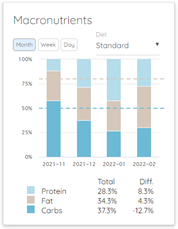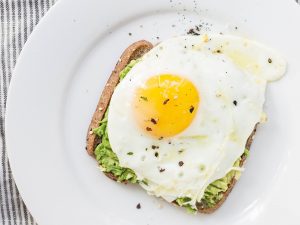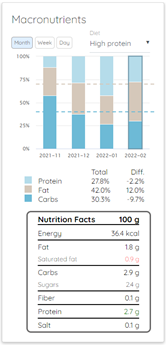If you’re a regular BitsaboutMe user, you’re probably familiar with the Nutri-Score widget, which shows you the nutritional value of your groceries from A/dark green to E/dark red.
Now, we’ve launched a new health widget that goes one step further: it analyzes the macronutrients of your food purchases and compares them to different diets’ ideal compositions.

But first things first: What are macronutrients, anyway?
Macronutrients
Macronutrients are energy-containing compounds that the body requires daily in relatively large amounts—hence “macro” from the Greek “makrós” for “large.” There are four macronutrients:
1 Proteins

Proteins help repair as well as build new cell material. Therefore, they are essential for healthy bones, muscles, skin, and more.
Protein provides around 4 kilocalories of energy per gram. Ideally, about 20 to 30% of your daily energy intake should come from protein. Excessive intake is not recommended, as this can increase the risk of developing kidney stones.
The macronutrient widget displays your groceries’ protein content in the upper part of the bars in light blue. To increase this percentage, you can, for example, increase your intake of eggs, meat and fish, dairy products, tofu, legumes, and nuts.
2 Fats
With around 9 kilocalories per gram, fats provide the most energy of all macronutrients. In addition to their function as a source of energy, fats are also very important for building cell membranes, protecting organs, and regulating body temperature.
Around one third of your daily energy intake should come from fat. It is important to prioritize healthy fats such as those found in eggs, avocados, nuts, olive oil, or tuna.
In the macronutrient widget, fat shows up brown in the middle of the bars. To lower a high fat content without sacrificing important protein, you can fill your shopping basket with more low-fat dairy products, such as cottage cheese or low-fat quark.
3 Carbohydrates

Carbohydrates, which include both healthy fiber and unhealthy sugars, are nonessential. Their sole purpose is to supply the body with energy and, unlike proteins and fats, carbohydrates aren’t necessary in order to produce certain compounds in the body.
Carbohydrates provide around 4 kilocalories of energy per gram—and quickly: The fastest carbohydrates are available to the body in just a few minutes. This is why carbohydrates are very important in professional sports.
For people who aren’t professional athletes, it’s usually recommended to get around 40 to 50% of daily energy from carbohydrates, for example, from whole grain products such as bread, pasta, or rice. In the macronutrient widget, carbohydrates feature at the bottom of the bars in dark blue.
4 Alcohol
Theoretically, alcohol, too, is a macronutrient, as it provides around 7 kilocalories of energy per gram. However, the body doesn’t require this psychoactive substance—and certainly not in large quantities. That’s why alcohol doesn’t show up in the macronutrient widget.
More Detailed View

Clicking on a specific bar in the macronutrient widget opens a more detailed view of the selected time period under the widget. Here, macronutrients are averaged per 100 g, particularly good (green) and bad (red) values are color-coded, and important fat and carbohydrate subtypes as well as salt are listed.
Saturated Fat
Animal products, certain vegetable oils, and many fast food and convenience products contain high levels of saturated fat. Since it can increase the risk of heart disease, it is recommended to limit the consumption of saturated fat. The macronutrient widget makes this easy: An excessive amount of saturated fat will automatically turn red.
Sugar
Many foods contain hidden sugar—even if they don’t taste sweet. For example, salad dressings or convenience foods. In the long run, high sugar intake can increase the risk of type 2 diabetes or heart disease, which is why limiting consumption is recommended for sugar, too. Again, the macronutrient widget helps you keep track by color-coding your values.
Fiber
Dietary fiber can be soluble or insoluble. Both are carbohydrates that the human body cannot digest and therefore cannot convert into energy. Instead, soluble fiber is broken down by bacteria and insoluble fiber is excreted. Oats, nuts, beans, and lentils, for example, are high in soluble fiber, which helps normalize blood sugar. Whole-grain bread, brown rice, and legumes, for example, are high in insoluble fiber, which helps regulate digestion.
Salt
Salt is a vital substance that helps regulate body fluids, for example. However, a very small amount is sufficient: It’s generally recommended to consume less than 5 grams per day. This is because too much salt can lead to increased blood pressure and thus to an increased risk of cardiovascular disease. If your macronutrient widget shows a red salt value, you can try to reduce processed foods such as cornflakes, convenience foods, and deli meats and sausages.
A High-Protein Diet

As aforementioned, proteins repair as well as build new cell tissue. Thus, many athletes rely on a protein-rich diet, as their body is exposed to more stress and thus has to undergo more repair. People who want to lose weight also benefit from a high-protein diet, as proteins can increase feelings of satiety. In the top-right corner of the macronutrient widget, you can change your diet from standard to high-protein and compare the ideal macronutrient composition with your groceries’ composition.
Effortlessly achieve healthier shopping and eating habits
As with the Nutri-Score widget, the macronutrient widget analyzes receipts. Consequently, the results won’t correspond exactly to your eating habits. Many people might buy a half a kilogram of butter and a one-liter bottle of oil in one day—but hardly anyone would eat all of that at once. Also, the widget can’t analyze groceries missing an imported or scanned receipt. Nonetheless, research projects at the ETH have shown that data on shopping behavior does allow conclusions to be drawn about eating behavior.
The macronutrient widget has a big advantage over apps that attempt to track everyday nutrition: It’s simple. You don’t need to scan barcodes, upload photos of your meals, calculate nutritional values based on packaging information, or take on any other tedious endeavors. Instead, the BitsaboutMe app and its macronutrient widget automatically import and analyze your groceries via Migros Cumulus and Coop Supercard. This makes the new macronutrient widget suitable for almost everyone—not just hardcore fitness fans.